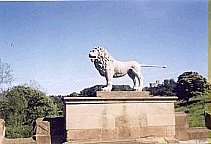|
BORDER TOWNS |
|
|
aLNWICK |
|
|
Bordering the cobbled square are 18th century buildings and the remains of coaching inns, one of the which, the White Swan, has the remarkable Olympic Room, created with materials salvaged from the Titanicís sister ship, which was broken up on the River Tyne in 1935. A wander around the narrow streets and the cobbled square can be very rewarding. The Georgian and Victorian houses built by affluent merchants are particularly imposing. In the centre of the square is the Shambles where animals were slaughtered and the nearby arcades housed stalls selling the meat, farm produce, and all kinds are other goods. Royal proclamations were read from the Market Cross and a market has been held in Alnwick for 800 years. This was a privilege only granted by the king. The town still holds a medieval fair during the week beginning on the last Sunday in June. Alnwick took its defences very seriously. Not only was it enclosed by a strong wall almost all which has now disappeared but there were a number of outlying towers which served as an early warning system and as preliminary defence. When peace came to the Borders, after the Union of the Crowns, Alnwick developed to the east and to the south serving a rich agricultural region. Much of the old walls and towers were dismantled for use as building stone and little now remains. The Hotspur Tower, through which you will pass if you enter Alnwick from the south has survived. Known
as the Hotspur Tower, the tower was in fact built long after Hotspur
lived. It is the original south gate and the area was, at one time,
considered for 'development.' |
|
 Click picture to enlarge.
Click picture to enlarge. |
The Hotspur Tower |
|
The tower was, in fact, built long after Hotspur lived. It is the last of four gate towers. At one time, it too was considered for 'development' but fortunately, it escaped the hands of the planners. |
|
|
The most famous Percy, Harry Hotspur, immortalised by William Shakespeare, was so named because of his impulsive nature.
He was born in Alnwick Castle on 20 May 1366, and is renowned for his part in the Battle of Otterburn. The London football club Tottenham Hotspur is named after the great Harry . The Percy family, not only owning a huge part of Northumbria, has holdings in London. |
|
|
|
|
|
The Percy Lion In the 1980s the whole statue was plunged into the river when a truck crashed into the bridge. On one occasion a boy sat on the lion's tail and the tail snapped off. Both the tail and the boy fell into the river below.
|
|
|
Apart from the site on which they once stood and, perhaps, a few fragments of stonework, little remains of others. Yet a visit can be very rewarding, if only to ponder over their historical past when they were mighty strongholds of note.
Many
of the castles and a selection of pele towers are listed here. They all
have Border family connections and are all worth a visit - if you have
the time, and there are many more waiting for you to discover. Hulne Park is a large area of natural woodland just north-west of Alnwick Castle. It is open to the public through the generosity of the Duke of Northumberland. Here you will find peace, quiet and wildlife. There is parking alongside the lodge. Within the grounds are the remains of 13th century Hulne Priory and Brizlee Tower, an 18th century lookout tower. There are many other attractive features nearby, including the remains of Alnwick Abbey. Coquet Island The lighthouse was built on the site of an old pele tower and part of the stonework being incorporated in the base of the lighthouse. The adjoining buildings, including the cottages, are all of medieval origin. You can take a boat trip around the Coquet Island from Amble. The island is famed for its abundance of birdlife.
|
|
|
Around and about Alnwick Alnwick took its defences very seriously. Not only was it enclosed by a strong wall almost all which has now disappeared but there were a number of outlying towers which served as an early warning system and as preliminary defence. The following have survived and are all worth a visit: Click to go to:
Alnwick Castle And to a splendid example of a fortified
church: |
|
